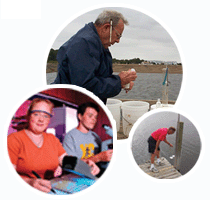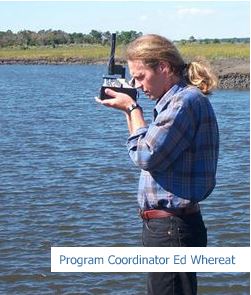Citizen Monitoring Program
2010 WATER QUALITY REPORTS AND SUMMARIES
Download and view our poster gallery below.
Sept 29 - Oct 22
Here is the 9th and final set of Citizen Monitoring Program Reports for 2010, covering the period of Sept 29 to Oct 22.
- Temperatures were about normal, and precipitation was somewhat above normal during the period.
- In general, Dissolved Oxygen conditions have greatly improved. Most readings were above 5 ppm and are not listed in the report. However, DO’s less than 4 ppm persisted in two upper tributaries of the Broadkill watershed.
- Accumulations of Nuisance Aquatic Vegetation remained minor.
- Total Enterococcus Bacteria levels were elevated in several locations (tributaries, canals and Fenwick Island bayside), but there were no significant rain events over the few days prior to collection.
- Harmful Algae Blooms were limited. In the estuary, there was a significant bloom of Heterosigma in Torquay canal. In the ocean, Karenia papilionacea persisted at low to moderate cell densities. On rare occasions, a small, more K. brevis-like cell was seen, but it is likely they were K. papilionacea in disguise.
Sept 8 - 29
Here is the eighth set of UD Citizen Monitoring Program Reports for 2010, covering the period of Sept 8 to Sept 29.
- It was rather dry for most of September. We caught up on rain in the last few days, but most of the data in the reports is from the rather dry period.
- Dissolved Oxygen conditions have improved somewhat, but low DO (< 4 ppm) persisted in many locations and severely low DO (< 2 ppm) persisted in a few canals and upper tributaries.
- Nuisance aquatic vegetation accumulations persisted in a few locations, but volumes were minor.
- Total Enterococcus bacteria levels were elevated in a few upper tributaries, a stream in the Broadkill, and at Fenwick Island bayside.
- In the estuaries, a few potentially Harmful Algae Blooms (Chattonella and Heterosigma) persisted in canals. In the ocean, we saw higher numbers of Karenia papilionacea during the last 2 weeks of September than over the past few years, and samples were taken more frequently. A few smaller cells that looked more like Karenia brevis were also detected. However, it appears that size variation in K. papilionacea may make our microscopic identifications less certain. Cell densities of either Karenia sp. were below their respective thresholds of concern for shellfish toxicity.
Aug 17 - Sept 8
Here is the seventh set of UD Citizen Monitoring Reports, covering the period of Aug 17 to Sept 8, 2010.
- We had a month’s worth of rain during the first week of this period, but then it became dry again.
- Low dissolved oxygen conditions (< 4 ppm) persisted in many locations, and severely low D.O. (< 2 ppm) was observed in several dead-end canals and in Old Mill Creek.
- Nuisance aquatic vegetation accumulations were widespread, but volumes were minor, with the exception of Diamond Pond.
- TE bacteria levels were generally reduced with the exception of a few sites. Most samples during this period were collected more than a week after the heavy rains.
- In the estuaries, blooms of potentially toxic algae (Heterosigma, Chattonella, Fibrocapsa Karlodinium, Prymnesium) were observed in some canals or at the Primehook boat ramp. In the ocean, low levels of Pseudonitzchia and Karenia papilionacea were detected.
Aug 5 - 18
Here is the sixth set of UD Citizen Monitoring Reports, covering the period of Aug 5 to Aug 18, 2010.
- It continued to be rather warm and dry during the first week of the period, but we finally received decent rain before the second week. (A month’s worth of rain fell on the 17-18th, but the information in these reports precedes that event.)
- As usual, observations of low dissolved oxygen (< 4 ppm) were widespread, but severely low values (< 2 ppm) were restricted to a few canals in the Inland Bays and one tributary of the Broadkill River.
- Major accumulations of Nuisance Aquatic Vegetation remain at Diamond Pond and at Wagamons Pond. Minor accumulations were observed elsewhere.
- Total Enterococcus bacteria were elevated in several locations including a few streams in the Broadkill watershed, and several tributaries and canals in the Inland Bays and Broadkill watersheds.
- Harmful algae blooms were fairly similar to the previous report. Prymnesium and Karlodinium have been blooming at the Prime Hook boat ramp, but have been joined by Anabaena. Chattonella and Fibrocapsa have continued to bloom in some canals and tributaries. In the ocean, Karenia papilionacea, the relatively less toxic, or non-toxic relative of Karenia brevis (a.k.a. FL Red Tide), was not seen, but Pseudonitzchia spp. persisted at low cell densities.
July 21 - Aug 6
Here is the fifth set of UD Citizen Monitoring Reports, covering the period of July 21 to Aug 6, 2010. As it is now Aug 13, the data is more stale than usual, but we will catch up with a fresh report at the end of next week.
- It was very hot and dry during the period, with a few weak spotty thunderstorms.
- Dissolved Oxygen conditions were poor and widespread. Severely low DO (< 2 ppm) was observed in several dead-end canals and in a few upper tributaries.
- Major accumulations of Nuisance Aquatic Vegetation were observed at Diamond Pond, particularly near the spillway. Minor accumulations were observed elsewhere.
- Total Enterococcus bacteria were elevated in many locations including a few streams and ponds in the Broadkill watershed, several tributaries and canals in the Inland Bays and Broadkill watersheds, and at one bay-side site in Fenwick Island.
- Harmful algae blooms were varied and widespread. Prymnesium and Karlodinium have been blooming at the Prime Hook boat ramp. Chattonella and Fibrocapsa have been blooming in some canals and tributaries, and some non-toxic diatoms and dinoflagellates have been blooming in Love Creek. In the ocean, Karenia papilionacea, the relatively less toxic, or non-toxic relative of Karenia brevis (a.k.a. FL Red Tide), was detected at very low cell densities, as was Pseudonitzchia spp..
June 30 - July 22
Here is the fourth set of UD Citizen Monitoring Reports, covering the period of June 30 to July 22, 2010.
- It has generally been hot and dry, but we received some significant rainfall from thunderstorms in the later half of the period.
- Low Dissolved oxygen readings were widespread, and severely low readings (<2ppm) were observed rather consistently in a few canals and upper tributaries.
- Nuisance aquatic vegetation accumulations were observed in many locations, but coverage was generally minor.
- Total Enterococcus bacteria levels were elevated in some streams, ponds, upper tributaries, and in a few locations on Fenwick Island bayside, and may have been related to recent rains.
- Harmful algae blooms in the estuaries were rather typical for mid-summer with moderately high cell densities of a few potentially toxic species in canals and upper tributaries. In the ocean and at the Inlets, HAB species have generally been at low cell densities, but there was a modest bloom of an unidentified, but presumably non-toxic, green dinoflagellate at the Tower Road ocean beach. A dense bloom of a potentially toxic flagellate called Prymnesium was observed at the Primehook NWR boat ramp.
June 15 - 30
Here is the third set of Citizen Monitoring Program Reports for 2010, covering the period of June 15 to June 30.
- The weather has been hot and humid, but we finally received 2-3” of rain from 3 significant thunderstorm events.
- Low dissolved oxygen readings (<4 ppm) have been widespread but intermittent. Severely low readings (<2.0 ppm) were restricted to a few canals and upper tributaries.
- Accumulations of Nuisance Aquatic Vegetation were somewhat less widespread, but persist in many locations.
- Total Enterococcus bacteria levels were elevated in some streams and tributaries of the Broadkill River, and in Little Assawoman Bay at the north end of Fenwick Island.
- Harmful algae species were widespread at low to moderate cell densities in the estuary and at the Inlets, but a significant bloom of the potentially toxic species, Chattonella cf. verruculosa was observed at the Prime Hook boat ramp.
- Also, maps of weekly dissolved oxygen readings and maps of dissolved oxygen boat transects of the bays have been updated at the link below.
May 29 - June 16
Here is the second set of Citizen Monitoring Program Reports for 2010, covering the period May 29 to June 16.
- The weather has continued to be rather warm and dry.
- Low dissolved oxygen readings have become more widespread, and we recorded values of 2.0 ppm or lower in a few locations (canals and 1 tributary).
- Accumulations of Nuisance Aquatic Vegetation continued to be reported at many sites, but the volumes were minor.
- Total Enterococcus bacteria levels continued to be elevated in some streams, tributaries and residential canals, and on the north end of Fenwick Island bayside.
- Harmful algae blooms were limited to modest blooms of Aphanizomenon sp. in Red Mill Pond, Chattonella subsalsa in a canal linked to Little Assawoman Bay, Prorocentrum minimum in a canal linked to Whites Creek, and a bloom of a non-toxic diatom in Guinea Creek. Pseudonitzchia spp. and Dinophysis spp. persist at the Inlets at low cell densities.
- As usual, these reports will be archived here.
May
Here is the first set of Citizen Monitoring Reports for 2010 covering the month of May. Subsequent reports will follow every 2 weeks or so during the summer. Previous years reports have been archived here.
- After many months above normal precipitation, April and May were relatively dry.
- Some tributaries and residential canals started to experience low dissolved oxygen (DO) in early May. There were several sites that recorded values between 2 and 4 ppm, but none below 2 ppm so far.
- Accumulations of Nuisance Aquatic Vegetation were reported at many sites, but the volumes were generally minor.
- Total Enterococcus (TE) Bacteria levels were elevated in several locations. Most sites still have insufficient data to calculate a geometric mean for the season.
- We saw a variety of modest blooms of harmful algae in tributaries and canals. Some had potentially toxic species (Heterosigma akashiwo, Karlodinium veneficum, Prorocentrum minimum, Chaetoceros spp.) and some had non-toxic species (small centric or pennate diatoms, Eutreptiella sp). Dinophysis and Pseudonitzchia (potentially toxic) were present at low densities at or near the inlets as well.



Copyright © 2016 University of Delaware College of Earth, Ocean, and Environment and the Delaware Sea Grant College Program | 302-645-4252


